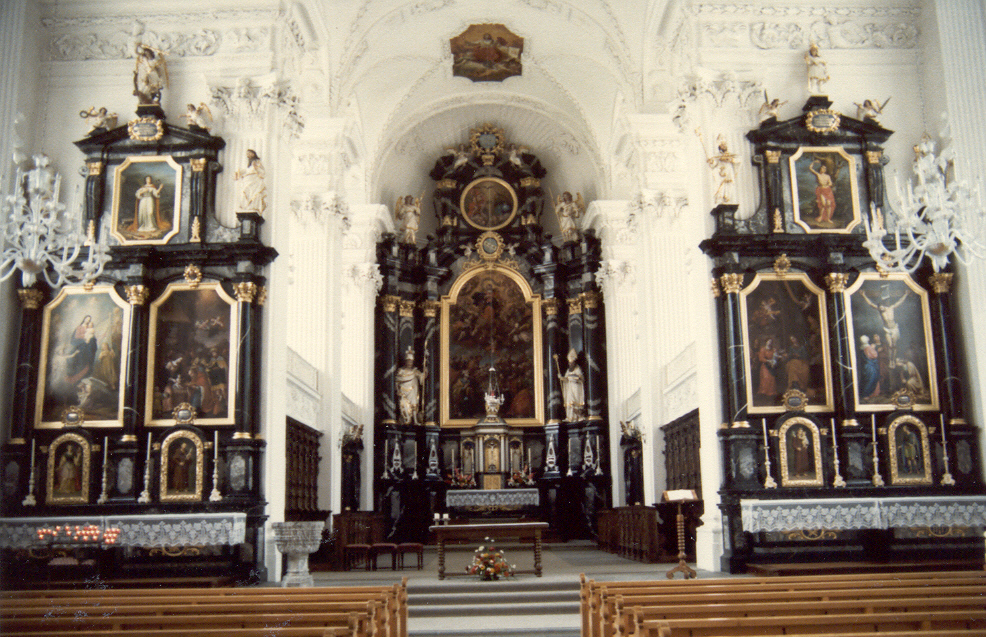
Come into the Lord's Presence Singing for Joy
Return to
Index The Catholic Faith
Return to Level
Two Topic Index
Home Page

The death and Resurrection of Our Lord Jesus Christ is the means by which he redeemed all mankind. The Mass is the re-presentation of this sacrifice. Now we will look at each part of the Mass.
We should approach not only Mass but the church building itself with the proper attitude. This means getting ready to take part in public worship of God. We get ready outwardly by wearing suitable clothes. We get ready inwardly by understanding our purpose in coming: to offer the Holy Sacrifice of the Mass with the priest and to be nourished by the Word of God and the precious Body and Blood of Our Lord Jesus Christ. We will come eagerly if we have thought deeply about the meaning of all these things.
The main parts of the Mass are the Liturgy of the word and the Liturgy of the Eucharist. (The word liturgy means the official public worship of the church.) But before these two parts comes a smaller part called the Introductory Rites. The Introductory Rites prepare us to take part worthily and to focus our hearts and our minds on the Mass.
First there is the Entrance Antiphon or Hymn during which the priest and the ministers enter the church and go to the altar. It is accompanied by signs of reverence, such as the carrying of candles, incense, and the Lectionary, the book which contains the Scripture readings used at Mass.
After the entrance song, the priest and the people make the Sign of the Cross. The priest greets the people: "The Lord be with you"; and the people answer: "And also with you".
Next is the Penitential Rite. The priest invites the people to think of their sins and be sorry for them. Then we all acknowledge our sins together, using one of three possible prayers of confession. This is not the same thing as the sacrament of Confession, but it helps to purify our hearts.
The prayer of confession usually used is called the Confiteor. it begins" "I confess to Almighty God, and to you, my brothers and sisters . . .", and it is followed by the invocations, "Lord, have mercy; Christ, have mercy; Lord, have mercy", or, "Kyrie eleison; Christe eleison; Kyrie eleison."
The Penitential Rite reminds us that merely coming to Mass doesn't make us any better than the rest of mankind. It reminds us that we are all in desperate need of God's forgiveness. Put another way, we must remember that Almighty God is Almighty God and that "we are a set of perfectly ridiculous creatures", as Msgr. Ronald Knox put it. Then we begin to see things in the right perspective.
After asking for forgiveness we are ready to praise God and to recall that his divine Son became man to redeem us from our sins and make us children of his Heavenly Father. We do so in the Gloria, a prayer that was once a Christmas hymn and begins with the words with which the angels greeted the shepherds: "Glory to God in the highest, and peace to his people on earth."
In this prayer we offer God praise, honor, and adoration, addressing Father, Son, and Holy Spirit. In particular, we plead with the God-man Jesus Christ to hear our prayers and ask him to give us a share in his sacrifice and his victory over death as they are re-presented in the Mass.
The Introductory Rites are concluded with the Opening Prayer or Collect. The priest invites the people to pray, and together they may spend some moments in silence so that they can realize that they are in God's presence and make their petitions. The the priest says the prayer that expresses the theme of the particular Mass, whether it be, for example, a Sunday, the feast day of a saint, or a feast of the Blessed Virgin.
These prayers are determined by the day of the Liturgical Year. The Liturgical Year is the Church's calendar; it has its own seasons and special feast days. We know about Advent and Lent, the two penitential seasons, and there are other seasons in the Liturgical Year. The seasons are to remind us of the life and teachings of Jesus and to help us live as he wants us to.
Not only are certain prayers and the readings of the Mass determined by the liturgical season; so are the church decorations and the priest's vestments. The color of the vestment is an indication of what season or feast day is being celebrated.
Used with the permission of The Ignatius Press 800-799-5534
Return to
Index The Catholic Faith
Return to Level
Two Topic Index
Top
Home Page